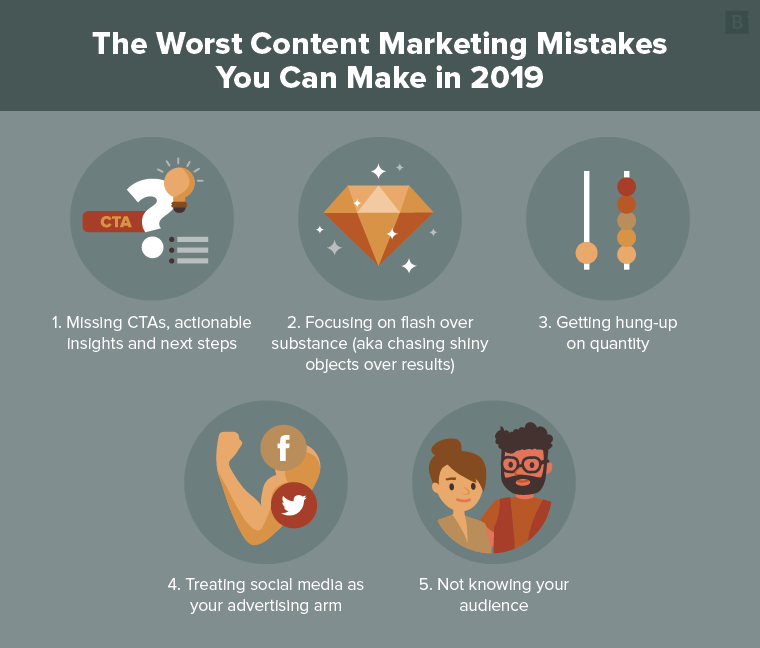Despite the frigid temperatures, buffeting polar winds and seemingly endless parade of winter storms, the start of a new year can be very rejuvenating for digital marketers. New year, new you, right? It’s a chance to correct those strategic and execution missteps you made over the course of the past 12 months and hit the ground running with a fresh start and a stunning content marketing strategy.
Luckily for you, we’ve combed through the depths of the internet and picked the brains of some of the brightest minds in digital marketing, content creation and SEO to compile what we humbly suggest is the most comprehensive list of content marketing mistakes to avoid. It’s like those guys in G.I. Joe always used to say, “knowing is half the battle.”
1. Missing CTAs, actionable insights and next steps
When you think of the most glaring content marketing mistakes you can make, what springs to mind? We posed this question to Daniel Waas, Chief Webinar Wrangler (amazing job title, btw) at GoToWebinar, and his response was immediate: “not providing actionable insights.”
“As readers we want an expert to tell us what to do,” he says. “As content marketers we want the reader to take the next action. Leaving the reader with no actionable next step doesn’t achieve either side’s goal.”
Even the most informative and high-quality content may fall flat and fail to play its role in your larger digital marketing campaign if it doesn’t provide possibilities for further engagement. The last thing you want is for a website visitor to finish reading a blog or viewing a video and say to themselves, “OK, now what?”
We’re really talking about two separate concepts here: First, content needs to have purpose – both for your target audience and for your content marketing efforts. Content for the sake of content is virtually worthless. It needs to speak directly to what matters most to your site visitors and prospective customers.
As readers we want an expert to tell us what to do. As content marketers we want the reader to take the next action. Leaving the reader with no actionable next step doesn’t achieve either side’s goal.
Once finished, they should come away having learned something entirely new or gained a fresh insight into a well-worn subject they never considered before.
Each piece of content also needs to serve a specific goal within the larger framework of your marketing strategy. Is it purely an organic-traffic driver? Is it a launching pad to other, more narrowly focused or in-depth content? Is it a lead generator? That role dictates its form and function.
Secondly, audiences need to be given tangible next steps to further engagement with your brand – and that means CTAs, regardless of what form they take. Even the most shameless, click-baity organic traffic magnet needs to provide audiences with some kind of action to move further down the sales funnel. That may be a dedicated call-to-action button, links to tangential blog posts or form fills – but as Waas points out, sometimes you have to lead your visitors around by the nose. They need a road map.
If you leave it solely up to the individual to take that next step, they may never move forward.
What to do instead
Waas has a pretty surefire, step-by-step process to guarantee your content has meaning and purpose for the reader – all it takes is a little bit of time in the planning stages to put yourself in your audience’s shoes.
“Take five minutes to write down the main takeaways you want the audience to walk away with,” he says. “Frame it as a promise: ‘After reading this content you will know…’ ”
Want an example (ideally of the Harry Potter-themed variety)? Waas’ got you covered:
“Imagine your blog title is ‘15 Ways to use Polyjuice Potion to surprise your Friends (#5 will touch you deeply),’ ” he begins. “Now, let’s complete our sentence: ‘After reading this content you will be able to:
- Make basic Polyjuice potion.
- Use Polyjuice potion to surprise anyone: your partner, parents, siblings, friends or colleagues (15 ideas included).
- Understand the risks and rare side effects of Polyjuice potion.
- Read the telltale signs that give away the illusion.
If your content doesn’t hit those beats, then you know it’s missing some important ingredients. In the parlance of the Potterverse, it’ll fall flat on its face faster than some chump from Hufflepuff.
Waas’ process actually mirrors some of the steps in Brafton’s own approach to creative content mapping and planning. Great minds think alike, I guess.

2. Focusing on flash over substance (aka chasing shiny objects over results)
The digital marketing blogosphere is a never-ending machine, churning out new content strategies, search-ranking updates and revised best practices that immediately render established wisdom outdated and ineffective. Keeping up with it all is a full-time job in and of itself.
Waas’ take: Don’t sweat implementing all the latest and (supposedly) greatest content marketing strategies as long as your existing approach is still raking in strong results.
“Have you ever read your favorite blogs and had FOMO creep in?” he asks. “Look at all these shiny new techniques everyone is adopting. Why aren’t we doing this? What if the train leaves the station without us?”
“Don’t worry. Take a deep breath. Close your browser. Now find something that’s working well for you and improve it a little.”
Have you ever read your favorite blogs and had FOMO creep in? Look at all these shiny new techniques everyone is adopting. Why aren’t we doing this? What if the train leaves the station without us?
What to do instead
As Waas points out, perfecting what’s already working for you may be a better use of your time and resources than struggling to incorporate some zany idea you picked up from a random marketing executive on Search Engine Journal.
You have something other digital marketers would kill for: a proven, successful content strategy. You’re seeing your good results and your keyword rankings continue to climb on Google and other search engines.
Keep tweaking that approach to get the most out of it. Don’t reinvent the wheel just to say you tried to innovate. You know who sold millions of albums over their career? The frickin’ Bee Gees. Meanwhile, Captain Beefheart’s winning over snobby music critics while struggling to pay his rent (I assume. I have no idea what Don Van Vliet’s financial situation was like).
That’s not to say that you never should try out new content marketing techniques or attempt to emulate your competitors’ successful strategies, but sometimes the most tried-and-true approaches got their reputation for a reason.
“I’m not suggesting not to try new things, but I do think we all should timebox the time we spend on emerging trends,” says Daniel. “If it really takes off, you’ll still be able to try it six months from now.”
We all should timebox the time we spend on emerging trends. If it really takes off, you’ll still be able to try it six months from now.
A little experimentation is good every now and then. But if it overwhelms the rest of your content marketing strategy, you may be unnecessarily rolling the dice instead of focusing on proven tactics.
3. Getting hung-up on quantity
Nothing induces anxiety in a digital marketer quicker than seeing a big empty space in your content calendar. Maintaining a consistent stream of published content feeds into every corner of your marketing strategy. New blog posts, infographics and videos are promoted on social media, shared via email marketing newsletters and help you capitalize on trending search terms.
While you always want to stay on top of the latest news and trends, don’t feel that you always have to, as Waas puts it, “feed the schedule.” It isn’t 2010 anymore; Google isn’t going to reward you for posting perfunctory blog posts every day of the week. Now more than ever, quality content beats a lot of content when it comes to search ranking (not to mention driving stronger engagement metrics).
“Yes, consistency is a good thing, but producing fluffy filler every week just means we’re consistently shoddy,” Daniel explains. “Wrestling with an epic beast of a post is hard work, but the end result is so much better.”
Wrestling with an epic beast of a post is hard work, but the end result is so much better.
Daniel has done his own wrestling. His recent post about webinar tips clocks in at around 9,756 words.
What to do instead
Resist that urge to plug every gap or hole in your content calendar with something. Take your time to really craft content that provides real value to your audience, even if that means dedicating a few extra days to the production process.
More and more, we’re seeing long-form content outperform quick reads. Dedicating more time to adding subject matter depth and scope to your content will achieve two goals that shorter content will have a hard time matching.
First, it’ll cast a wider net as far as ranking keywords goes, exposing your content to a larger audience. The more comprehensive it is, touching on topics and concepts related to the core subject, the more eyeballs it’s likely to grab.
Second, going beyond surface-level insights and discussion points with any subject matter helps build your topic authority. And audiences often find highly detailed, in-depth content to be more relevant and useful than material that just skims over the most salient talking points.

That’s to say nothing of the fact that you can outmaneuver your competitors who may be producing their own content covering the same ground by expanding your breadth of scope to be as comprehensive as possible.
Do you have aspirations of one day landing in Google’s Answer Box or Featured Snippet for a particular search term, query or keyword? Answering that question in the most complete fashion is your best bet to grab that coveted spot atop a SERP.
So, don’t stress so much about getting as much content as possible out the door, and start focusing on making every item on your content calendar as good as possible.
4. Treating social media as your advertising arm
Social media is such a new touch point (relatively speaking) for brands that many wind up completely misunderstanding both the format and the audience.
The biggest and most common offense? Turning your Twitter feed into an unending parade of advertisements and overt sales pitches.
Obviously, the end goal of any content marketing strategy – including social media efforts – is to drive revenue through higher sales figures. But it’s not a simple “Point A to Point B” scenario. There are numerous cogs in the content marketing machine, slowly building organic traffic, website engagement, lead generation and other meaningful metrics that build toward those juicy KPIs that make the C-suite lick their chops: conversion rates, qualified leads, closed sales, client acquisitions, etc.
Even the most successful content marketing campaigns can take several months to show positive results. If businesses only use raw sales figures and attached revenue to measure the success of your social media efforts, then they’re missing the point entirely.
“I was part of a meeting when a company was figuring out if they should invest more time in Twitter,” recalls The ID Group owner Mark Masters. “I will never forget these words from the managing director, ‘Will Twitter make the company an extra $150,000 per year?’”
Will Twitter make the company an extra $150,000 per year?
Your social media presence needs personality and to make strides engaging and communicating with your audience. It can’t be all about chasing down those sales leads all the time. As Masters noted, the rules of engagement on social media are very different than those on other channels. Even B2B-focused networks like LinkedIn would find direct sales pitches and nonstop advertising offputting.
Consumer-focused brands need to exercise even more caution on social media channels and avoid coming across as too salesy and promotional. It takes a deft hand to pump up businesses on social networks without appearing aggressively self-aggrandizing.
What to do instead
A little advertising goes a long way on social media. Don’t overload your Twitter, LinkedIn and Facebook feeds with self-serving posts and links. Definitely don’t let your social media presence be dominated exclusively by automated posts lacking a single speck of personality or brand identity.
Which isn’t to say that brand marketers should never indulge in a little self-promotion every now and then. You want to champion your wins, company culture and brand messaging, but you have to balance that out with posts that help establish a dialogue with your audience and build a long-lasting social media presence.
What we’re saying is, tweet in moderation.
5. Not knowing your audience
Everyone likes to think they know their audience and what they’re interested in, but do you really?
As digital marketing guru Neil Patel notes, it’s easy to fall in love with a particularly unique and exciting idea for content only to later realize it doesn’t really speak to your audience at all.
Maybe the topic is interesting but ultimately irrelevant to your industry. Maybe the message is directed at an office drone rather than the movers and shakers that actually make purchasing decisions in their organization.
Whatever the issue is, you need to step back and reassess who you’re actually trying to speak to.
Step back and reassess who you’re actually trying to speak to.
What to do instead
Research who your potential customers are, what interests them and what they care about most. We are talking about, of course, creating buyer personas.
Maybe you already have a slew of buyer personas and customer demographics at your fingertips, but do they tell the full story about your sales targets?
We’ve talked before about fleshing out buyer personas to gain a more complete picture of your target audience and letting them guide your content creators’ efforts, but it bears reiterating. Knowing exactly who your audience members are is the first step to a successful content marketing plan. That insight should dictate what content type, format, tone and voice have the best chance to engage – not to mention the specific topics and talking points that site visitors will find the most compelling and persuasive.
Is your reader the upper-level decision-maker who has final say on new business contracts and purchases? Or is it more likely that someone further down the corporate foodchain is your primary content consumer?
The best buyer personas are detailed and informative, delving into information like job title, professional and personal goals, interests, engagement preferences, etc. The more specific those profiles are, the better.
Once you’ve rounded out your stable of buyer personas and understand what role your site visitors play in the purchasing process, you can start to reshape your content strategy to match those relationships.
Now if only there was some oft-repeated quote from a popular ‘80s Saturday morning cartoon to succinctly wrap up this whole concept in a neat little bow …
That’s the one! Thanks, Roadblock.
And thank you, Daniel Waas, for sharing with us your insights regarding some of the most common and damaging content marketing mistakes that trip people up.
Look, no digital marketer bats a thousand. Just think of every content marketing misstep as a learning experience, and be sure to apply those lessons to your 2019 campaigns.





